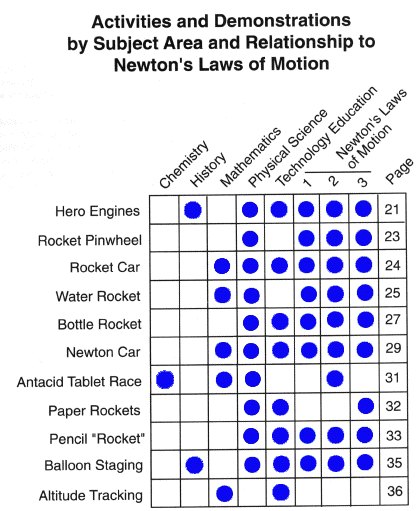Rockets Teacher's
Guide with Activities
National
Aeronautics and Space Administration
Office of Human Resources and Education
Education Division
This publication is in the Public Domain and is not protected by copyright. Permission is not required for duplication.
We only ask that you credit NASA as the source.
Original Document: EP-291 July 1993
Modified Document: EG-2003-01-108-HQ 2003
Acknowledgments:
This section of the Beginner's Guide to Rockets is an on-line copy
of a NASA Educational Publication.
The publication is available in printed form from the NASA
Educational Publications and Products web site.
This on-line copy was originally developed for the Learning Technologies Project
at NASA Glenn Research Center. There is very little
math, no hyperlinks, and no interactive pages in this section.
To explore the math and science of rockets more interactively,
the student is directed to the
Beginner's Guide Index.
The original publication
was developed for the National Aeronautics and Space Administration with
the assistance of the many educators of the Aerospace Education Services
Program, Oklahoma State University.
Writer:
Gregory L. Vogt,
Ed.D.
Teaching From Space Program
NASA Johnson Space Center Houston, TX
Editors:
Carla R. Rosenberg
Teaching From Space Program
NASA Headquarters Washington, DC
Roger Storm
High School Science Teacher and Summer Intern
NASA Glenn Research Center
Tom Benson
Senior Research Engineer
NASA Glenn Research Center
Special Thanks to:
Timothy J. Wickwenheiser
Chief, Advanced Mission Analysis Branch
NASA Glenn Research Center
Gordon W. Eskridge
Aerospace Educational Specialist
Oklahoma State University
Dale M. Olive
Teacher, Hawaii
Narcrisha S. Norman
NASA Coop Student
Old Dominion University
How To Use This
Guide
Rockets are the oldest
form of self-contained vehicles in existence. Early rockets were in use
more than two thousand years ago. Over a long and exciting history, rockets
have evolved from simple tubes filled with black powder into mighty vehicles
capable of launching a spacecraft out into the galaxy. Few experiences
can compare with the excitement and thrill of watching a rocket-powered
vehicle, such as the Space Shuttle, thunder into space. Dreams of rocket
flight to distant worlds fire the imagination of both children and adults.
With some simple
and inexpensive materials, you can mount an exciting and productive physical
science unit about rockets for children, even if you don't know much about
rockets yourself. The unit also has applications for art, chemistry, history,
mathematics, and technology education. The many activities contained in
this teaching guide emphasize hands-on involvement. It contains background
information about the history of rockets and basic rocket science to make
you an "expert."
The guide begins
with background information sections on the history of rocketry, scientific
principles, and practical rocketry. The sections on scientific principles
and practical rocketry are based on Isaac Newton's Three Laws of Motion.
These laws explain why rockets work and how to make them more efficient.
The background sections
are followed with a series of physical science activities that demonstrate
the basic science of rocketry. Each activity is designed to be simple
and take advantage of inexpensive materials. Construction diagrams, material
and tools lists, and instructions are included. A brief discussion elaborates
on the concepts covered in the activities and is followed with teaching
notes and discussion questions.
Because many of the
activities and demonstrations apply to more than one subject area, a matrix
chart has been included on this page to assist in identifying opportunities
for extended learning experiences. The chart identifies these subject
areas by activity and demonstration title. In addition, many of the student
activities encourage student problem- solving and cooperative learning.
For example, students can use problem-solving to come up with ways to
attach fins in the Bottle Rocket activity. Cooperative learning is a necessity
in the Altitude Tracking and Balloon Staging activities.
The length of time
involved for each activity and demonstration will vary according to its
degree of difficulty and the development level of the students. Generally,
demonstrations will take just a few minutes to complete. With the exception
of the Altitude Tracking activity, most activities can be completed in
less than an hour.
A Note on Measurement
In developing this
guide, metric units of measurement were employed. In a few exceptions,
notably within the "materials needed" lists, English units have been listed.
In the United States, metric- sized parts such as screws and wood stock
are not as accessible as their English equivalents. Therefore, English
units have been used to facilitate obtaining required materials.

Any comments, concerns, or questions should be addressed
to: |
Developer: Tom
Benson
Responsible NASA Official: Tom Benson
|
|
